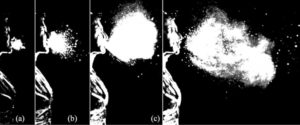By David Kiser
It’s dark. It’s wet. It produces mucous. It captures dust and foreign matter. It’s your nose and sinuses. The nose and sinuses are part of your respiratory system. What is the purpose of your nose and sinuses? No one knows about the nose. Some experts think the sinuses might help humidify the air before it goes into the lungs. It does help filter the air you breathe.
We do know the nose and sinuses can provide a home for bad germs or pathogens. We also know people can carry these germs without being sick themselves. These people are known by the medical community as “carriers” and they are very common. In fact, about 30% of the population carries Staphylococcus aureus (or staph) in their nose without symptoms. Two people out of every hundred carry colonies of the very dangerous MRSA (Methicillin-resistant Staphylococcus aureus) in their nose without being symptomatic. There are many other pathogens that can colonize in the nose. Staph and MRSA are just two.
Once someone becomes a carrier, it can be difficult to decolonize (kill or remove the germs) their nose. Even if the germs are removed, the flora in the nose and sinuses attract the same germs and seem to be a nice home for these dangerous pathogens. This is dangerous to all of us. One sneeze can spread pathogens far and wide.

This sequence illustrates the evolution of the multiphase turbulence cloud that suspends droplets emitted during a sneeze. Shown here are times ranging from 7 to 340 milliseconds post sneeze onset.
This form of disease transmission has a lot to do with how people become infected in the community. The danger it presents is serious. MRSA can be deadly. Even for people in great health. About 900 people in the United States die every month from MRSA alone. All staph infections are serious and should be treated as such. There are other pathogens that can live in the nose. Staph and MRSA are just two.
As professionals in residential cleaning, why do we need to know about noses? How can we have a role protecting ourselves and others? How can we provide specialized services?
There are four important areas we can help reduce this type of threat. Education, Testing, Cleaning and Communication.
Education makes people aware of danger. It motivates them to be serious about the threats that pose harm. Learn about the flora in your sinuses and what makes it healthy. Good nutrition is critical. There are links to gut health and sinus health. Work on your gut health.
Testing is also a preventative. Ask your doctor to test your sinuses for pathogens. If you test positive get treatment and test again after your treatment. Learn how to treat your sinuses beyond just antibiotics. There are things you can do that make pathogens not want to hang out in your nose and sinuses. Colloidal silver has been shown to be effective in reducing or eliminating pathogens in the sinuses. Essential oils may be helpful also. This is information not generally shared with the public.
Keep cuts covered until they heal completely. Use alcohol to disinfect cuts or scrapes. Wash hands with soap and water for at least 20 seconds. Wash hands often and EVERY time after contact with suspect surfaces or people. Do not share personal items like towels or razors.
Cleaning is the first line of defense in healthcare. Incorporate “hygienic cleaning” into your cleaning service operation. This type of cleaning is more than just wiping doorknobs and other high touch areas. It requires understanding of the proper cloths or wipes and effective cleaning protocols and disinfecting solutions. Most importantly, it requires specific training. This service can be an add-on or can be incorporated into a regular service where people are at increased risk. Post-surgical patients or the immune compromised would greatly benefit from this service.
Communication is critical. You can keep your nose clean, so to speak, yet others can transmit the disease from their nose. Communicating accurate knowledge, you acquire about the nose, sinuses and disease transmission is a good way to reduce disease in the community. This can be 1-on-1 with your clients. It can be speaking with your Chamber of Commerce or other local groups. Remember, Professional cleaners are on the front lines of good healthcare. Sharing science-based knowledge elevates you and your company as industry experts. People feel safe with experts. This is the best kind of marketing!
References:
Chronic Rhinosinusitis and Irritable Bowel Syndrome: A Case Report
Mikhail Kogan, MD, Carlos Cuellar Castillo, MS, and Melissa S. Barber, MS
Integr Med (Encinitas). 2016 Jun; 15(3): 44–54.
Bactericidal and Antibiotic Synergistic Effect of Nanosilver Against Methicillin-Resistant Staphylococcus aureus
Khalid A. Ali Abdel Rahim1,2,* and Ahmed Mohamed Ali Mohamed3
Jundishapur J Microbiol. 2015 Nov; 8(11): e25867.
Published online 2015 Nov 21. doi: 10.5812/jjm.25867
PMCID: PMC4740956
PMID: 26862383

Diagnosis, Methicillin-Resistant Staphylococcus aureus
To diagnose S. aureus, a sample is obtained from the infection site and sent to a microbiology laboratory for testing. If S. aureus is found, the organism should be further tested to determine which antibiotic would be effective for treatment.
Doctors often diagnose MRSA by checking a tissue sample or nasal secretions for signs of drug-resistant bacteria. Current diagnostic procedures involve sending a sample to a lab where it is placed in a dish of nutrients that encourage bacterial growth (a culture). It takes about 48 hours for the bacteria to grow. However, newer tests that can detect staph DNA in a matter of hours are now becoming more widely available. This will help healthcare providers decide on the proper treatment regimen for a patient more quickly, after an official diagnosis has been made.
In the hospital, you might be tested for MRSA if you show signs of infection, or if you are transferred to a hospital from another healthcare setting where MRSA is known to be present. You also might be tested if you have had a previous history of MRSA.
For more articles, subscribe to our newsletter.






